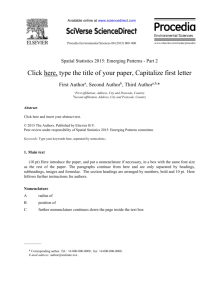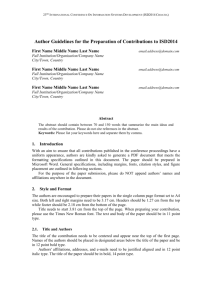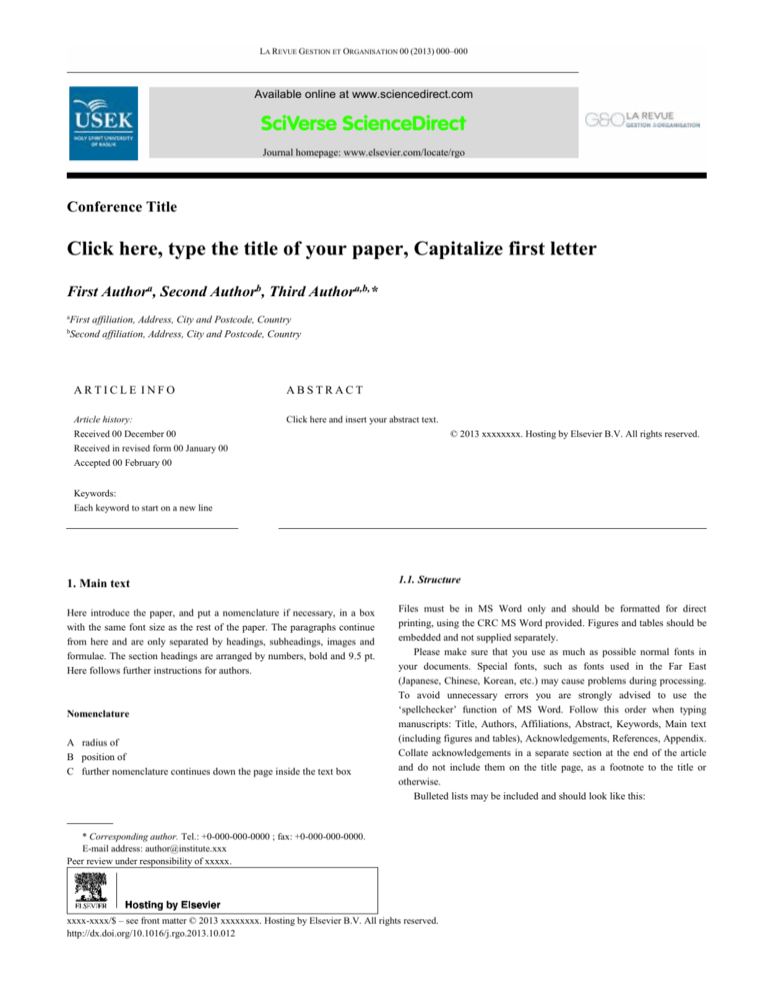
LA REVUE GESTION ET ORGANISATION 00 (2013) 000–000
Available online at www.sciencedirect.com
Journal homepage: www.elsevier.com/locate/rgo
Conference Title
Click here, type the title of your paper, Capitalize first letter
First Authora, Second Authorb, Third Authora,b,*
a
First affiliation, Address, City and Postcode, Country
Second affiliation, Address, City and Postcode, Country
b
ARTICLE INFO
ABSTRACT
Article history:
Click here and insert your abstract text.
Received 00 December 00
© 2013 xxxxxxxx. Hosting by Elsevier B.V. All rights reserved.
Received in revised form 00 January 00
Accepted 00 February 00
Keywords:
Each keyword to start on a new line
1. Main text
1.1. Structure
Here introduce the paper, and put a nomenclature if necessary, in a box
with the same font size as the rest of the paper. The paragraphs continue
from here and are only separated by headings, subheadings, images and
formulae. The section headings are arranged by numbers, bold and 9.5 pt.
Here follows further instructions for authors.
Files must be in MS Word only and should be formatted for direct
printing, using the CRC MS Word provided. Figures and tables should be
embedded and not supplied separately.
Please make sure that you use as much as possible normal fonts in
your documents. Special fonts, such as fonts used in the Far East
(Japanese, Chinese, Korean, etc.) may cause problems during processing.
To avoid unnecessary errors you are strongly advised to use the
‘spellchecker’ function of MS Word. Follow this order when typing
manuscripts: Title, Authors, Affiliations, Abstract, Keywords, Main text
(including figures and tables), Acknowledgements, References, Appendix.
Collate acknowledgements in a separate section at the end of the article
and do not include them on the title page, as a footnote to the title or
otherwise.
Bulleted lists may be included and should look like this:
Nomenclature
A radius of
B position of
C further nomenclature continues down the page inside the text box
* Corresponding author. Tel.: +0-000-000-0000 ; fax: +0-000-000-0000.
E-mail address: author@institute.xxx
Peer review under responsibility of xxxxx.
xxxx-xxxx/$ – see front matter © 2013 xxxxxxxx. Hosting by Elsevier B.V. All rights reserved.
http://dx.doi.org/10.1016/j.rgo.2013.10.012
2
LA REVUE GESTION ET ORGANISATION 00 (2013) 000–000
1.5. General guidelines for the preparation of your text
First point
Second point
And so on
Ensure that you return to the ‘Els-body-text’ style, the style that you
will mainly be using for large blocks of text, when you have completed
your bulleted list.
Please do not alter the formatting and style layouts which have been
set up in this template document. As indicated in the template, papers
should be prepared in double column format suitable for direct printing
onto paper with trim size 210 x 280 mm. Do not number pages on the
front, as page numbers will be added separately for the preprints and the
Proceedings. Leave a line clear between paragraphs. All the required style
templates are provided in the file “MS Word Template” with the
appropriate name supplied, e.g. choose 1. Els1st-order-head for your first
order heading text, els-abstract-text for the abstract text etc.
1.2. Tables
All tables should be numbered with Arabic numerals. Every table should
have a caption. Headings should be placed above tables, left justified.
Only horizontal lines should be used within a table, to distinguish the
column headings from the body of the table, and immediately above and
below the table. Tables must be embedded into the text and not supplied
separately. Below is an example which the authors may find useful.
Table 1 - An example of a table.
An example of a column
heading
Column A (t)
Column B (t)
And an entry
1
2
And another entry
3
4
And another entry
5
6
Avoid hyphenation at the end of a line. Symbols denoting vectors and
matrices should be indicated in bold type. Scalar variable names should
normally be expressed using italics. Weights and measures should be
expressed in SI units. All non-standard abbreviations or symbols must be
defined when first mentioned, or a glossary provided.
1.6. File naming and delivery
Please title your files in this order ‘procedia acronym_conference
acronym_authorslastname’. Submit both the source file and the PDF to
the Guest Editor.
Artwork filenames should comply with the syntax “aabbbbbb.ccc”,
where:
a = artwork component type
b = manuscript reference code
c = standard file extension
Component types:
gr = figure
pl = plate
sc = scheme
fx = fixed graphic
1.7. Footnotes
Footnotes should be avoided if possible. Necessary footnotes should be
denoted in the text by consecutive superscript letters1. The footnotes
should be typed single spaced, and in smaller type size (7 pt), at the foot
of the page in which they are mentioned, and separated from the main text
by a one line space extending at the foot of the column. The Els-footnote
style is available in the MS Word for the text of the footnote.
Please do not change the margins of the template as this can result in
the footnote falling outside printing range.
1.3. Construction of references
References must be listed at the end of the paper. Do not begin them on a
new page unless this is absolutely necessary. Authors should ensure that
every reference in the text appears in the list of references and vice versa.
Indicate references by (Van der Geer, Hanraads, & Lupton, 2000) or
(Strunk & White, 1979) in the text.
Some examples of how your references should be listed are given at
the end of this template in the ‘References’ section, which will allow you
to assemble your reference list according to the correct format and font
size.
1.4. Section headings
Section headings should be left justified, bold, with the first letter
capitalized and numbered consecutively, starting with the Introduction.
Sub-section headings should be in capital and lower-case italic letters,
numbered 1.1, 1.2, etc, and left justified, with second and subsequent lines
indented. All headings should have a minimum of three text lines after
them before a page or column break. Ensure the text area is not blank
except for the last page.
2. Illustrations
All figures should be numbered with Arabic numerals (1,2,3,….). Every
figure should have a caption. All photographs, schemas, graphs and
diagrams are to be referred to as figures. Line drawings should be good
quality scans or true electronic output. Low-quality scans are not
acceptable. Figures must be embedded into the text and not supplied
separately. In MS word input the figures must be properly coded.
Lettering and symbols should be clearly defined either in the caption or in
a legend provided as part of the figure. Figures should be placed at the top
or bottom of a page wherever possible, as close as possible to the first
reference to them in the paper.
The figure number and caption should be typed below the illustration
in 8 pt and left justified [Note: one-line captions of length less than
column width (or full typesetting width or oblong) centered]. For more
guidelines and information to help you submit high quality artwork please
1
Footnote text.
LA REVUE GESTION ET ORGANISATION 00 (2013) 000–000
visit:http://www.elsevier.com/wps/find/authorsview.authors/
authorartworkinstructions. Artwork has no text along the side of it in the
main body of the text. However, if two images fit next to each other, these
may be placed next to each other to save space. For example, see Fig. 1.
3
microfilm or any other reproductions of similar nature and translations.
Authors are responsible for obtaining from the copyright holder, the
permission to reproduce any figures for which copyright exists.
Acknowledgements
Acknowledgements and Reference heading should be left justified, bold,
with the first letter capitalized but have no numbers. Text below continues
as normal.
Appendix A. An example appendix
Authors including an appendix section should do so before References
section. Multiple appendices should all have headings in the style used
above. They will automatically be ordered A, B, C etc.
Fig. 1 - (a) first picture; (b) second picture.
A.1. Example of a sub-heading within an appendix
3. Equations
Equations and formulae should be typed in Mathtype, and numbered
consecutively with Arabic numerals in parentheses on the right hand side
of the page (if referred to explicitly in the text). They should also be
separated from the surrounding text by one space.
E
E
J C T const. P
E
C
m
1 P
(1)
4. Online license transfer
All authors are required to complete the Procedia exclusive license
transfer agreement before the article can be published, which they can do
online. This transfer agreement enables Elsevier to protect the copyrighted
material for the authors, but does not relinquish the authors’ proprietary
rights. The copyright transfer covers the exclusive rights to reproduce and
distribute the article, including reprints, photographic reproductions,
There is also the option to include a subheading within the Appendix if
you wish.
REFERENCES
Van der Geer, J., Hanraads, J. A. J., & Lupton, R. A. (2000). The art of writing
a scientific article. Journal of Science Communication, 163, 51–59.
Strunk, W., Jr., & White, E. B. (1979). The elements of style (3rd ed.). New
York: MacMillan.
Mettam, G. R., & Adams, L. B. (1999). How to prepare an electronic version
of your article. In B. S. Jones & R. Z. Smith (Eds.), Introduction to the
electronic age (pp. 281–304). New York: E-Publishing Inc.
Fachinger, J., den Exter, M., Grambow, B., Holgerson, S., Landesmann, C.,
Titov, M., et al. (2004). Behavior of spent HTR fuel elements in aquatic
phases of repository host rock formations, 2nd International Topical
Meeting on High Temperature Reactor Technology. Beijing, China, paper
#B08.
Fachinger, J. (2006). Behavior of HTR fuel elements in aquatic phases of
repository host rock formations. Nuclear Engineering & Design, 236, 54.

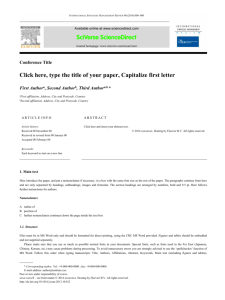
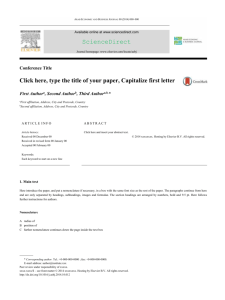
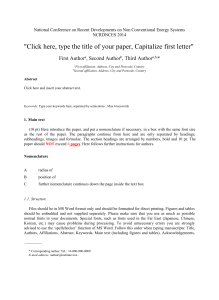
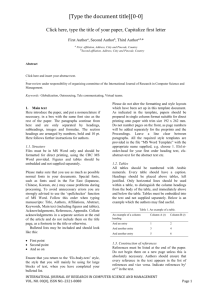
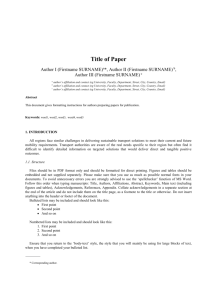
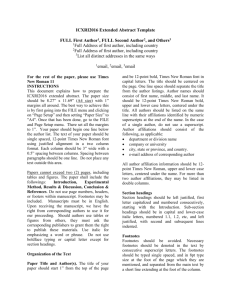
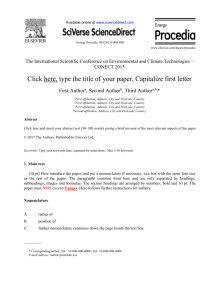
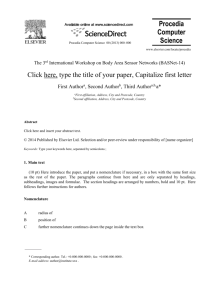
![Abstracts_files/Template_Full_Paper_PPEPPD2016[2]](http://s3.studylib.net/store/data/006986283_1-1c902679c64614beba0f844d40330ee7-300x300.png)

